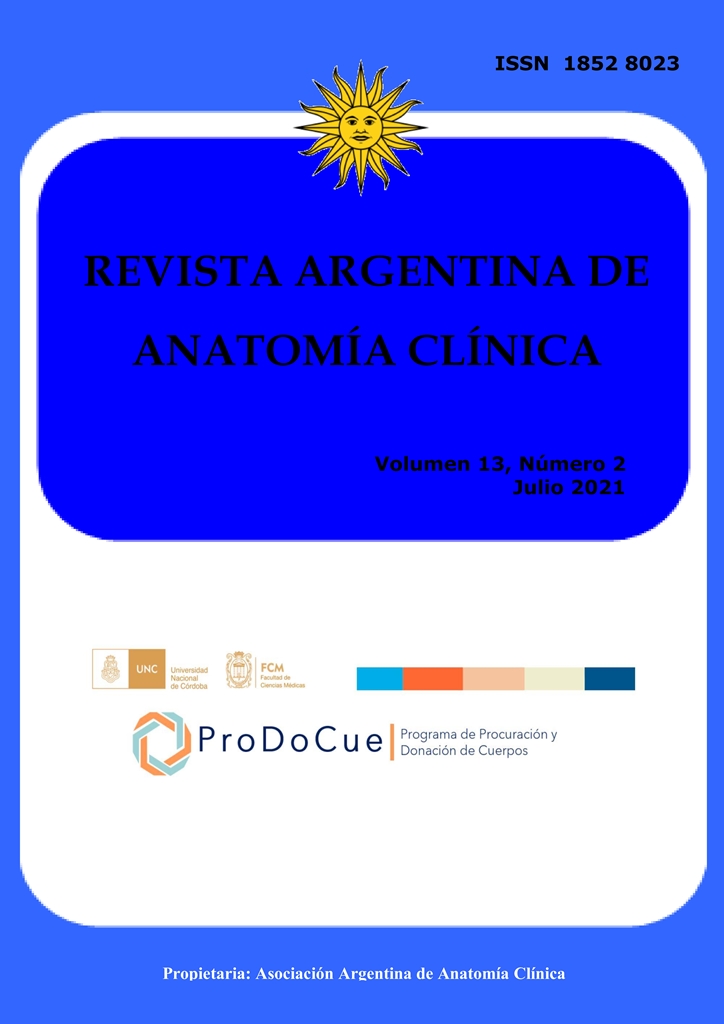LARVICIDAL CONSEQUENCES AND PHYSICAL CHANGES FOLLOWING THE UTILITY OF SOME PETROCHEMICAL FUELS IN EMBALMING SERVICES
DOI:
https://doi.org/10.31051/1852.8023.v13.n2.32985Keywords:
Petrochemical fuels; Larvicidal consequences; Embalmment; AnatomyAbstract
An ideal embalming fluid: eliminates infection and health hazards; maintains ante-mortem appearance; eliminates sequence of decomposition; prevents occupation of larvae and fungi. No embalming formulae had met these attributes, hence, the quest to formulate an ideal embalmment fluid across the globe continues with the present study designed to hypothesize the larvicidal consequences and physical changes following addition of some petrochemical fuels to common embalming fluid using Wistar rats under bioethics standard. An embalmment composition was propounded with Group A (Control) having 75% of the composition along with 25% of sterile water. Groups B, C and D having 75% of the composition with 25% of Kerosene, Petrol and Diesel respectively. First stage: embalmment of two rats per group and monitoring for 12weeks for physical changes. Second stage: delayed embalmment by immersion of one rat per group that was occupied by larvae in different embalming mixtures and death rate monitored to assess larvicidal consequences of the mixture. Analysis done with Statistical Package for Social Sciences (version-25) and the hypotheses were tested at 0.05 level of significance. The mean fluid needed to embalm 1g of tissue was 0.6±0.04ml. Retainment of ante-mortem weight was highest in Diesel-mixture after 12weeks of embalmment. Petrol-mixture killed all the larvae within 60seconds while others had no larvicidal effect per se. Petrol-mixture was best in damping offensive odour from necrotic tissue. Diesel-mixture conferred lustre beauty on the integumentary system. Petrol-mixture had unambiguous larvicidal effect. This study was veritably ‘Evidence Based Anatomy’ with the innovative outcomes in embalming affairs.
Downloads
References
Ajmani ML. 1998. Embalming chemicals and Fluids. In: Embalming Principles and Legal Aspects. Jaypee Brothers Medical publishers. India, 111-30.
Bernat JL, Bratton SL, Gries CJ, Rushton CH. 2010. The circulatory–respiratory determination of death in organ donation. Critical Care Medicine 38: 963-70.
Biasutto SN, Sharma N, Weighlein AH, Benia FM, McBride J. 2014. Human bodies to teach anatomy: importance and procurement – experience with cadaver donation. Rev Arg de Anat Clin 6: 72-86.
Bosze Z, Houdebine LM. 2006. Application of Rabbits in Biomedical Research: A review. World Rabbit Science 14: 1-14.
Brenner E. 2014. Human body preservation – old and new techniques. J Anat 224: 316–44.
Christoph R, Schmidt B, Steinberner U, Dilla W, Karinen R. 2006. Glycerol. Ullmann's Encyclopedia of Industrial Chemistry. Ullmann's Encyclopedia of Industrial Chemistry. doi:10.1002/14356007.a12_477 (Accessed June 2020).
Curl H, O’Donnell K. 1977. Chemical and physical properties of refined petroleum products. Marine Ecosystems Analysis Program Boulder, Colorado. National Oceanic and Atmospheric Administration Technical Memo-randum ERL MESA- 17: 6-14.
Guild S. 2008. IAEA Safety Standards Core Management and Fuel Handling for Research Reactors. International Atomic Energy Agency. Vienna, 24-28.
Johnson EC, Johnson GR, Johnson M. 2012. The origin and history of embalming. In: Mayer RG, editor. Embalming-History, Theory, and Practice. New York: McGraw-Hill, 467–509.
Marquet PA, Santoro CM, Latorre C, Standen VG, Abades SR. 2012. Emergence of social complexity among coastal hunter-gatherers in the Atacama Desert of northern Chile. Proc Natl AcadSci 109:14754–60.
Martinez B. 2012. Gunther von Hagens' Plastination Technique. Embryo Project Encyclopedia URL: https://embryo.asu.edu/ handle/10776/3947 (Accessed July 2020).
McKone HT. 1999. Embalming – chemistry for eternity. Chem Matters 17: 12–13.
Ofusori DA, Ayoka AO, Adeeyo OA, Adewole SO. 2009. Mixture of Kerosene and Xylene: a contribution to clearing agents. International Journal of Morphology 27: 211-18.
Piombino-Mascali D, Aufderheide AC, Johnson-Williams M, Zink AR. 2009. The Salafia method rediscovered. Virchows Arch 454:355–57.
Seiple J. 2009. Instructor of Embalming at Gupton-Jones College of Funeral Service. Personal interview conducted Sept 4 2009. URL:https://science.howstuffworks.com/science-vs-myth/afterlife/embalming6.htm (Accessed July 2020).
Sharquie KE, Najim RA. 2004. Embalming with honey. Saudi Med J 25:1755–56.
Staff E. 2013. History of Embalming and Restorative Arts. Funeral.EliteCME.com, 83-85. URL: https://s3.amazonaws.com › EliteCME_ WebSite_2013 › pdf (Accessed February 2021).
Stapountzis H, Tzavellas P, Moros T. 1991. Effects of Turbulence on the Mixing and Chemical Reaction for Cross Flow and Coflowing jets. In: Johansson A.V., Alfredsson P.H. (eds) Advances in Turbulence 3. Springer, Berlin, Heidelberg, 300-11.
Trompette P, Lemonnier M. 2009. Funeral embalming: the transformation of a medical innovation. Sci Stud 22: 9–30.
Downloads
Published
How to Cite
Issue
Section
License
Copyright (c) 2021 Sunday O. Popoola

This work is licensed under a Creative Commons Attribution-NonCommercial 4.0 International License.
Authors retain copyright and grant the journal right of first publication with the work simultaneously licensed under a Creative Commons Attribution License that allows others to share the work with an acknowledgement of the work's authorship and initial publication in this journal. Use restricted to non commercial purposes.
Once the manuscript has been accepted for publications, authors will sign a Copyright Transfer Agreement to let the “Asociación Argentina de Anatomía Clínica” (Argentine Association of Clinical Anatomy) to edit, publish and disseminate the contribution.



